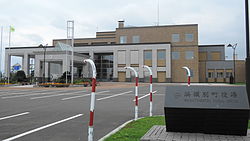Hamatonbetsu, Hokkaido
Hamatonbetsu
浜頓別町 | |
|---|---|
 Hamatonbetsu town hall | |
 Location of Hamatonbetsu in Hokkaido (Sōya Subprefecture) | |
 | |
| Coordinates: 45°7′26″N 142°21′35″E / 45.12389°N 142.35972°E | |
| Country | Japan |
| Region | Hokkaido |
| Prefecture | Hokkaido (Sōya Subprefecture) |
| District | Esashi |
| Area | |
| • Total | 401.59 km2 (155.05 sq mi) |
| Population (July 1, 2024) | |
| • Total | 3,263 |
| • Density | 8.1/km2 (21/sq mi) |
| Time zone | UTC+09:00 (JST) |
| City hall address | Chūō-Minami 1-ban, Hamatonbetsu-chō, Esashi-gun, Hokkaidō 098-5792 |
| Climate | Dfb |
| Website | Official website |
| Symbols | |
| Bird | Tundra swan |
| Flower | Caltha |
| Tree | Sakhalin Spruce |


Hamatonbetsu (浜頓別町, Hamatonbetsu-chō) is a town located in Sōya Subprefecture, Hokkaido, Japan.[1] As of 1 July 2024[update], the town had an estimated population of 3,263 in 1841 households, and a population density of 8.1 people per km2.[2] The total area of the town is 401.59 km2 (155.05 sq mi).
Geography
[edit]Hamatonbetsu is located in northeast Hokkaido; it faces the Sea of Okhotsk to the east where, during the winter, there is drift ice. Coastal areas of the town are marshy, and mountains spread out in the western and southern parts of the town. Lake Kutcharo designated a Ramsar site in July 1989, and host nearly 300 bird species either year round or as part of the avians' migratory pattern.[3] Parts of the town are within the borders of the North Okhotsk Prefectural Natural Park.[4]
- Mountains: Mount Jumon (761m)
- Rivers: Tonbetsu River, Toyosambe River
- Lakes: Lake Kutcharo
Neighbouring municipalities
[edit]Climate
[edit]Hamatonbetsu has cold and temperate climate considered to be Dfb according to the Köppen-Geiger climate classification. There is a considerable amount of rainfall even during months that typically experience dry weather. The average annual temperature in Hamatonbetsu is 5.9 °C. Each year, there is an approximate 1112 mm of precipitation. The temperatures are highest on average in August, at around 19.1 °C, and lowest in January, at around -6.6 °C.[5]
| Climate data for Hamatonbetsu (1991−2020 normals, extremes 1977−present) | |||||||||||||
|---|---|---|---|---|---|---|---|---|---|---|---|---|---|
| Month | Jan | Feb | Mar | Apr | May | Jun | Jul | Aug | Sep | Oct | Nov | Dec | Year |
| Record high °C (°F) | 8.2 (46.8) |
9.3 (48.7) |
15.9 (60.6) |
23.6 (74.5) |
29.7 (85.5) |
30.6 (87.1) |
33.6 (92.5) |
33.4 (92.1) |
30.9 (87.6) |
24.7 (76.5) |
19.0 (66.2) |
10.2 (50.4) |
33.6 (92.5) |
| Mean daily maximum °C (°F) | −3.3 (26.1) |
−2.6 (27.3) |
1.4 (34.5) |
8.0 (46.4) |
13.7 (56.7) |
16.9 (62.4) |
20.7 (69.3) |
22.8 (73.0) |
20.3 (68.5) |
14.1 (57.4) |
5.6 (42.1) |
−1.0 (30.2) |
9.7 (49.5) |
| Daily mean °C (°F) | −6.3 (20.7) |
−6.3 (20.7) |
−2.0 (28.4) |
4.0 (39.2) |
9.2 (48.6) |
12.8 (55.0) |
16.9 (62.4) |
19.0 (66.2) |
15.8 (60.4) |
9.6 (49.3) |
2.4 (36.3) |
−3.8 (25.2) |
5.9 (42.7) |
| Mean daily minimum °C (°F) | −10.3 (13.5) |
−11.1 (12.0) |
−6.1 (21.0) |
0.1 (32.2) |
4.9 (40.8) |
9.0 (48.2) |
13.7 (56.7) |
15.7 (60.3) |
11.7 (53.1) |
5.3 (41.5) |
−1.0 (30.2) |
−7.2 (19.0) |
2.1 (35.7) |
| Record low °C (°F) | −27.4 (−17.3) |
−27.4 (−17.3) |
−24.6 (−12.3) |
−10.2 (13.6) |
−4.2 (24.4) |
−2.0 (28.4) |
1.0 (33.8) |
4.0 (39.2) |
1.9 (35.4) |
−4.1 (24.6) |
−16.8 (1.8) |
−19.5 (−3.1) |
−27.4 (−17.3) |
| Average precipitation mm (inches) | 62.1 (2.44) |
46.7 (1.84) |
50.2 (1.98) |
47.6 (1.87) |
61.0 (2.40) |
65.0 (2.56) |
116.9 (4.60) |
118.9 (4.68) |
121.4 (4.78) |
106.4 (4.19) |
101.9 (4.01) |
83.3 (3.28) |
997.0 (39.25) |
| Average rainy days | 17.5 | 15.1 | 13.5 | 10.6 | 10.8 | 10.2 | 11.3 | 11.7 | 13.1 | 14.5 | 17.7 | 19.2 | 165.2 |
| Mean monthly sunshine hours | 59.7 | 82.3 | 132.2 | 166.3 | 174.0 | 148.2 | 132.9 | 143.1 | 165.3 | 135.7 | 71.9 | 56.6 | 1,470.1 |
| Source 1: JMA[6] | |||||||||||||
| Source 2: JMA[7] | |||||||||||||
Demographics
[edit]Per Japanese census data, the population of Hamatonbetsu is as shown below. The town is in a long period of sustained population loss.[8]
| Year | Pop. | ±% |
|---|---|---|
| 1940 | 5,529 | — |
| 1950 | 7,543 | +36.4% |
| 1960 | 8,074 | +7.0% |
| 1970 | 7,130 | −11.7% |
| 1980 | 6,503 | −8.8% |
| 1990 | 5,573 | −14.3% |
| 2000 | 4,957 | −11.1% |
| 2010 | 4,172 | −15.8% |
| 2020 | 3,448 | −17.4% |
History
[edit]The name of "Tonbetsu" derives from the Ainu language word to-un-pet, which translates "river entering lake", and which referred to the Tonbetsu River which enters Lake Kutcharo. In 1878, the villages of Esashi, Tonbetsu, Utanobetsu, and Rebun were established in Esashi District, Kitami Province. In 1909 the four villages merged to form the village of Esashi; however, Tonbetsu was separated out in April 1916. In April 1921, Tonbestu was divided into Tonbetsu and Nakatonbetsu villages. Tonbetsu was raised to town status on November 1, 1951 and was renamed Hamatonbetsu due to its coastal location.
Government
[edit]Hamatonbetsu has a mayor-council form of government with a directly elected mayor and a unicameral town council of ten members. Hamatonbetsu, as part of Soya sub-prefecture, contributes one member to the Hokkaido Prefectural Assembly. In terms of national politics, the town is part of the Hokkaido 12th district of the lower house of the Diet of Japan.
Economy
[edit]The local economy of Hamatonbetsu is centered on commercial fishing and dairy farming. In particular, Hamatonbetsu is noted for its scallops, salmon and crabs.
Education
[edit]Hamatonbetsu has four public elementary schools and one public junior high school operated by the town government. The town has one public high school operated by the Hokkaido Board of Education.
Transportation
[edit]Railways
[edit]Hamatonbetsu has not had any passenger railway services since the closing of the JR Hokkaido Tempoku Line in 1989. The nearest railway station is Minami-Wakkanai Station or Otoineppu Station on the Sōya Main Line, a 1.5 hour bus ride away.
Highways
[edit]Local attractions
[edit]- Kitami Kamuimisaki
- Lake Kutcharo
- Hamatonbetsu onsen
Notable people from Hamatonbetsu
[edit]- Masato Hatanaka, musician
Mascot
[edit]
Hamatonbetsu's mascot is Swatton (スワットン) who is a gentle yet clumsy pig dressed as a tundra swan. He lives in areas surrounding Lake Kutcharo. His birthday is August 21. According to Ainu legend, he first appeared during the Jomon period to bring food and medical needs for good health and protection from crimes and natural disasters. Nowadays, he is no longer a god anymore. Instead, he is now a ballet dancer (who is auditioning for Swan Lake) and the assistant to the mayor. He still helps the town to children and adults around the world and brings happiness during difficult times by his dance moves while promoting the town. He knows laughter is the best medicine.[9]
References
[edit]- ^ "浜頓別(町)" [Hamatonbetsu]. Nihon Daihyakka Zensho (Nipponika) (in Japanese). Tokyo: Shogakukan. 2013. OCLC 153301537. Archived from the original on 2007-08-25. Retrieved 2013-09-06.
- ^ "Hamatonbetsu Town official statistics" (in Japanese). Japan.
- ^ "Kutcharo-ko". Ramsar Sites Information Service. Archived from the original on 16 February 2020. Retrieved 25 April 2018.
- ^ "North Okhotsk Prefectural Natural Park". Hokkaidō Prefecture. Retrieved 8 February 2012.
- ^ Sarufutsu climate: Average Temperature, weather by month
- ^ 観測史上1~10位の値(年間を通じての値). JMA. Retrieved February 21, 2022.
- ^ 気象庁 / 平年値(年・月ごとの値). JMA. Retrieved February 21, 2022.
- ^ 人口推移 [Population Change] (in Japanese). Hamatonbetsu, Hokkaido: Town of Hamatonbetsu. 2013. Archived from the original on 2016-03-04. Retrieved 2013-09-10.
- ^ "浜頓別町公式マスコットキャラクター「スワットン」公式プロフィール". Hamatonbetsu.
External links
[edit] Media related to Hamatonbetsu, Hokkaidō at Wikimedia Commons
Media related to Hamatonbetsu, Hokkaidō at Wikimedia Commons- Official Website (in Japanese)



